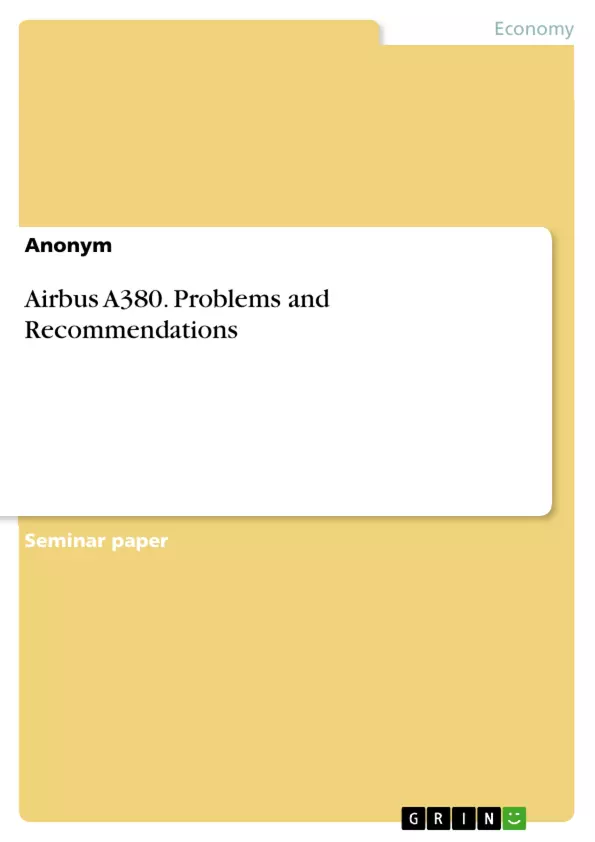The production of the A380 aircraft ran two years behind schedule, causing financial losses, bad reputation and disappointment. To make decisions for future improvements and strategies, the situation has been analysed for management purposes.
This report addresses the current situation and the causes of the problems by covering systems, operations and other important factors. It gives recommendations for improvement for these areas as well as for people, technological and organisational issues.
It is shown that even a multinational company such as Airbus suffers from stultifying problems, using different systems at their plants or internal rivalries amongst top managers. Complex operations and dispersed plants further hampered the project.
Finally it is recommended for Airbus, to integrate operations and systems in a better way, to introduce new systems to all plants and to ease organisational structures.
Inhaltsverzeichnis (Table of Contents)
- 1) Introduction
- 2) The Current Situation
- a. Operation Processes
- b. Systems
- c. Operations and Systems Integration
- d. Interrelated Problems
- e. Business Requirements
- 3) Conclusion
- 4) Recommendations
- a. Improvement Approach
- b. Information Systems
- c. Operation Processes
- d. People
- e. Technology
- f. Organisation and Structure
Zielsetzung und Themenschwerpunkte (Objectives and Key Themes)
The objective of this report is to analyze the reasons behind the two-year delay in the delivery of the Airbus A380, resulting in €5.5 billion over budget. The analysis aims to identify strengths and weaknesses in Airbus' systems and operations, providing recommendations for future improvements and strategic decision-making. The report uses a case study approach, incorporating information from various sources to offer a comprehensive overview of the issues.
- Operational complexities and integration challenges
- Systemic inefficiencies and their impact on project timelines
- Organizational structure and its influence on project success
- Technological limitations and their contribution to delays
- The interplay between various factors contributing to project failure
Zusammenfassung der Kapitel (Chapter Summaries)
1) Introduction: This introductory chapter sets the stage for the report, outlining its purpose, which is to investigate the reasons for the significant delays in the A380 project and to offer recommendations for future improvements. It highlights the substantial financial and reputational impact of these delays, emphasizing the need for a thorough analysis to guide future strategic decision-making. The chapter also briefly describes the methodology used, referencing the sources of information utilized in the investigation, such as a case study and various journal articles. The scope is clearly defined, focusing on operational and systemic factors influencing the project's timeline and budget overruns.
2) The Current Situation: This chapter delves into the specifics of the A380 project's problems, highlighting the significant cost overruns and delays. It explores the complexities of the A380's manufacturing process, involving numerous companies across multiple countries. The section on operational processes uses a process map (Illustration 1) to visually represent the geographically dispersed nature of the manufacturing process, illustrating the inherent logistical challenges. This section lays the groundwork for the subsequent analysis of systems, integration issues, and interrelated problems within the project.
Schlüsselwörter (Keywords)
Airbus A380, project delays, cost overruns, operational complexities, systems integration, organizational structure, multinational project management, recommendations for improvement, case study analysis.
Airbus A380 Project Delay Analysis: Frequently Asked Questions
What is the main focus of this report?
This report analyzes the reasons behind the two-year delay and €5.5 billion cost overrun in the Airbus A380 project. It aims to identify strengths and weaknesses in Airbus' systems and operations, offering recommendations for future improvements and strategic decision-making.
What methodology is used in this report?
The report uses a case study approach, incorporating information from various sources to offer a comprehensive overview of the issues. It includes process maps and draws on journal articles and other relevant data.
What are the key themes explored in the report?
The report explores operational complexities and integration challenges, systemic inefficiencies, organizational structure's influence on project success, technological limitations, and the interplay of factors contributing to project failure.
What are the main chapters of the report?
The report includes an introduction, a chapter detailing the current situation (including operational processes, systems, integration, problems, and business requirements), a conclusion, and a chapter providing recommendations (covering improvement approaches, information systems, operational processes, people, technology, and organizational structure).
What does the introduction chapter cover?
The introduction outlines the report's purpose, highlights the financial and reputational impact of the A380 delays, and briefly describes the methodology and sources of information used. It clearly defines the scope of the analysis, focusing on operational and systemic factors.
What does the "Current Situation" chapter cover?
This chapter details the A380 project's cost overruns and delays, explores the complexities of its manufacturing process (geographically dispersed across multiple companies and countries), and uses a process map to illustrate logistical challenges. It lays the groundwork for analyzing systems, integration issues, and interrelated problems.
What type of recommendations are provided in the report?
The recommendations cover improvement approaches for operational processes, information systems, people management, technology utilization, and organizational structure. They aim to prevent similar issues in future projects.
What are the key words associated with this report?
Key words include: Airbus A380, project delays, cost overruns, operational complexities, systems integration, organizational structure, multinational project management, recommendations for improvement, and case study analysis.
What is the overall objective of the analysis?
The objective is to provide a thorough understanding of the reasons for the A380 project's failure, leading to actionable recommendations for improving future project management and strategic decision-making at Airbus.
Who is the intended audience for this report?
While not explicitly stated, the report's structured and professional nature suggests it is intended for academic use, potentially for researchers, students, or professionals in project management and operations analysis.
- Citar trabajo
- Anonym (Autor), 2011, Airbus A380. Problems and Recommendations, Múnich, GRIN Verlag, https://www.grin.com/document/214005



